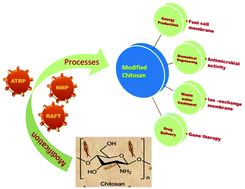Recent advances in RDRP-modified chitosan: a review of its synthesis, properties and applications
Abstract
Modified chitosan (CS) has kindled considerable research interest in the last few decades due to its outstanding biological, chemical and physical properties. Generally, CS can be re-formed with different structural modifications by using various functional groups. Due to the addition of these functional groups, the physicochemical properties of CS can be enhanced without hampering the degree of polymerization inherent in the CS. Different techniques were employed for the modification of CS. Among these, modifications via reversible-deactivation radical polymerization (RDRP) are found to be the most efficient. RDRP techniques mostly include atom transfer radical polymerization (ATRP), reversible addition–fragmentation chain transfer polymerization (RAFT) and nitroxide-mediated polymerization (NMP). These methods provide tailored modifications of CS with controlled molecular weight and dispersity (Đ) leading to better mechanical properties compared to the modifications performed via conventional methods. Various analytical techniques such as FT-IR, UV-Vis, 1H-NMR, 13C-NMR, XRD, SEM, TEM, TGA, DSC, GPC, etc. are employed to characterize and elucidate the physico-chemical properties of these modified polymers. These modifications make CS a strong candidate for different applications in diverse fields of pharmaceuticals, biomedicine, water treatment, etc. This review covers the recent advances in the syntheses, properties and applications of modified CS via RDRP techniques.



 Please wait while we load your content...
Please wait while we load your content...